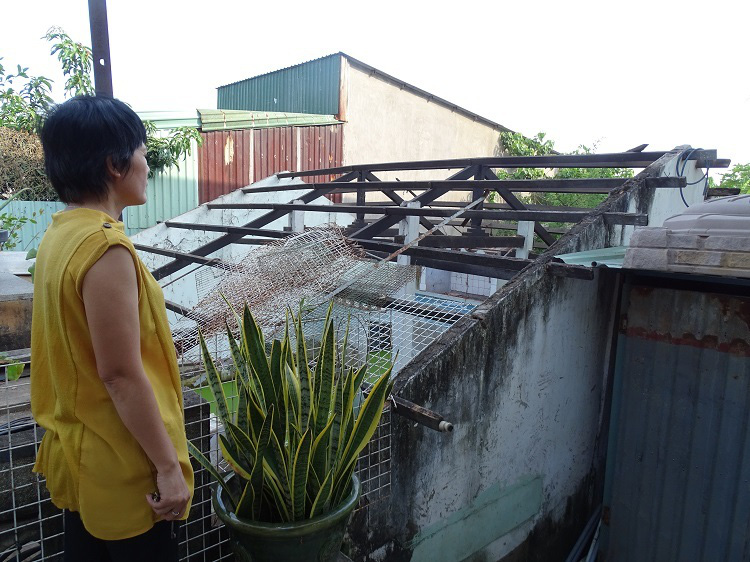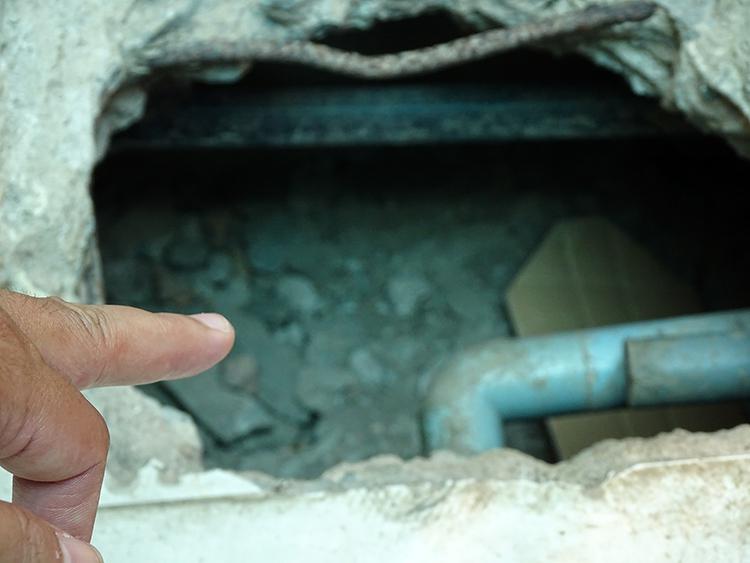Standing next to what used to be her house, Truong Thi Binh, 42, says: "Now it's nothing but some kind of a pond. Water rises by almost two meters down there."
Her house used to stand on Lam Hoanh Street, An Lac Ward, Binh Tan District.
"With the water ferns and trash, mosquitoes have made it their home, so we have had to remove the roof to make it a bit airy," she says.
All that is left of the sunk house now is its core framework and cracked walls, and what used to be its roof is just several hand spans above the street.

People in her neighborhood frequently comment that if people from elsewhere visited the place, they would not believe that it was a part of Ho Chi Minh City, Vietnam’s biggest city and economic hub.
An Lac Ward covers 4.59 square kilometers to the west of the city.
Over the past ten years, it has dropped 81.4 centimeters, making it the area hit hardest by subsidence so far in southern Vietnam, according to results released late last month by the Department of Water Resources Management under the Ministry of Natural Resources and Environment after a survey of 339 locations in the Mekong Delta and Ho Chi Minh City.
Binh and her family moved to another house nearby around 10 years ago.
Many of her neighbors chose to lift the floors of their houses. But that has not helped much.
The house that Binh's family now stays has also started tilting, after they "fixed it" just two years ago.
The door of this house has tipped and a crack runs along the wall, widening to more than a centimeter as it reaches the roof, sending water down the house every time it rains.
"We've been living here in constant fear. This area used to be paddy fields and when it became a residential area, we spent a lot of money on the foundation but that has not helped."
Binh's brother moved with his family to District 7 in the city's south recently after his house tilted to one side, leaving cracks on the wall and sending the platform at the front door up 50 centimeters.
That house has been abandoned and is now covered with grass.

Two kilometers from Binh's neighborhood, residents of the Nam Hung Vuong residential area are suffering from a similar situation.
As Nguyen Van Long, 67, stomped his foot on the yard of his house, a hollow sound could be heard. He removed a few bricks covering the floor, revealing a pit some 40 centimeters deep.
"This has been going on for years. The speed with which the subsidence has been happening has left the yard hollow and the façade of the house could stumble anytime," Long said, worry writ large on his face.
Two years ago, the floor of his house had sunk and its tiles were broken. He had to make a concrete slab more than 10 centimeters thick to reinforce the floor. Despite this, he can still feel the sinking very clearly. The base of his house gate has already subsided to below the sidewalk level.

Almost every family in the Nam Hung Vuong residential area has raised the foundation of their houses to half or one meter above the street level.
Too many bore wells
And the residential houses are not only one affected. The office of An Lac People's Committee is lined with cracks, from its walls to its columns. Three years ago, the staircases in front of the building started sinking, exposing chunks of concrete.
Dinh Hoang Giang, the ward's chairman, said subsidence has been happening in the area for decades and there has been no official scientific explanation for the situation.
He said he believes that apart from the natural low level, excessive groundwater pumping has caused the dangerous sinking that the An Lac Ward has been experiencing.
Nguyen Gia Thai Binh, deputy chairman of Binh Tan District, backed Giang's analysis.
Binh said local people in the district have access to tap water, but it is a fact that many families still prefer groundwater for their daily use.
The district's department of natural resources and environment has said it will draw up a list of households that are using groundwater without permission and impose strict sanctions on violations. It is not clear when this will be done and what its impact will be.
According to the environment ministry's water resources department, the subsidence in both the city and the Mekong Delta region is caused by a combination of both natural and human activities, including excessive groundwater extraction and impacts of urban constructions, infrastructure construction and increasing traffic.
About 9,650 bore wells are functional in the area, with a total capacity of 1.97 million cubic meters per day. Of these, 1,900 are in HCMC, with a total capacity of 520,000 cubic meters per day.
Besides, there are over a million smaller wells for residential use, with a total capacity of 840,000 cubic meters per day, the department said.
In October, the HCMC administration said it will write to the environment ministry and ask for approval to stop groundwater exploitation in the city by 2025.
The city wants to stop granting permits for businesses and local households to extract groundwater instead of merely restricting the practice and urging its residents to stop or use less groundwater as it has been doing thus far.
Given the seriousness of the situation, some people say that the controversial assessment by Climate Central, a U.S.-based nonprofit news organization, that most of southern Vietnam, including the Mekong Delta and the nation's economic hub, Saigon, could be flooded by 2050 does not sound so far-fetched.

















